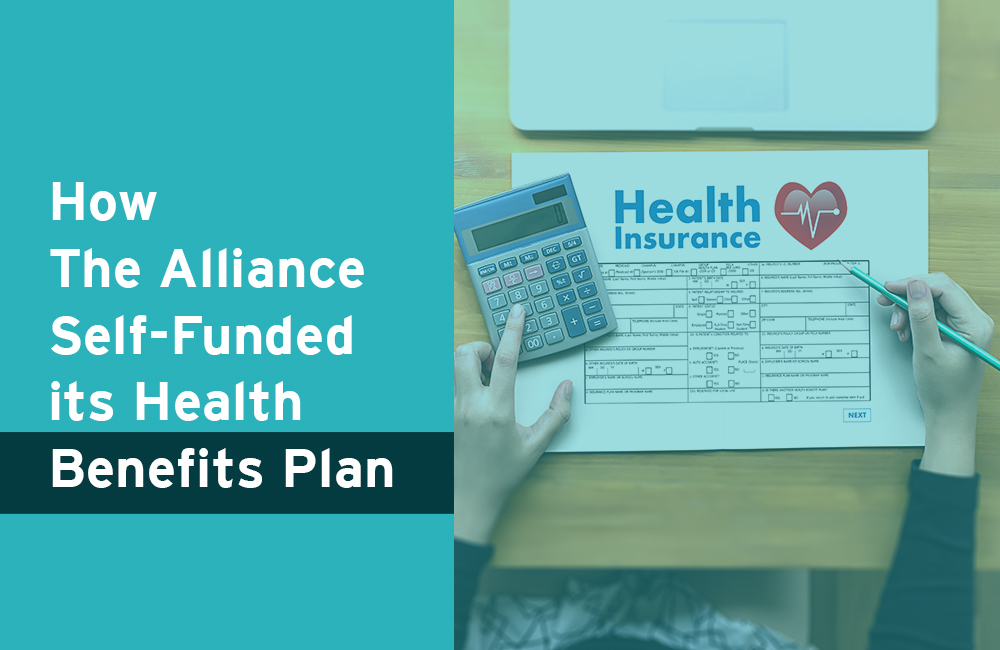
How The Alliance Self-Funded its Employee Health Benefits Plan
[et_pb_section fb_built=”1″ admin_label=”section” _builder_version=”3.22″ global_colors_info=”{}”][et_pb_row admin_label=”row” _builder_version=”3.25″ background_size=”initial” background_position=”top_left” background_repeat=”repeat” global_colors_info=”{}”][et_pb_column type=”4_4″ _builder_version=”3.25″ custom_padding=”|||” global_colors_info=”{}” custom_padding__hover=”|||”][et_pb_text admin_label=”Text” _builder_version=”3.27.4″ background_size=”initial” background_position=”top_left” background_repeat=”repeat” global_colors_info=”{}”]
The following is a Q&A with Melina Kambitsi, Ph.D., The Alliance’s Senior Vice President of Business Development & Strategic Marketing. Melina spearheaded The Alliance’s self-funded health benefits plan in 2019, which covered 23 employees, proving that small businesses can successfully self-fund. As The Alliance plans for its 3rd renewal, she answered some questions about successes and challenges in how The Alliance self-funded its health benefits plan.
Why did The Alliance choose to self-fund their health benefits plan?
The Alliance aims to serve as the voice for self-funded employers, yet we ourselves were not yet self-funded as a small sized employer with only 23 employees on the health plan. As a not-for-profit cooperative, we strive to remain a trusted partner to our employers and their brokers, so we wanted to make the same investment into our employees that our members were making to not only align incentives, but to align with our goal and mission of moving health care forward. In doing so, we’re showcasing to prospective members – who can help strengthen The Alliance’s pooled purchasing power – that we are taking the same risks, fighting the same fight, making the same investments into our staff, and ultimately, have the same interests at heart.
What was the biggest challenge of self-funding such a small health plan?
Hands-down, for any company, the challenge is always going to be lack of data. When it’s your first year of self-funding, you have no data to begin with. You’re taking somewhat of a leap of faith. You know that you’ll save money down the road by improving the plan, but there’s a lot of question marks on year one.
That said, because we’ve been working with great clients and partners for over 30 years, we were fortunate to be able to lean on a broker who is an expert in self-funding and who maintains a good relationship with the HMOs. Jeff Ireland, from M3, was able to obtain sufficient data from the HMO with which we were insured, and that was sufficient for our re-insurer to provide us with a very competitive stop-loss quote. At the end of the day, self-funding is about having the right partners; it’s extremely important to have a good consultant who knows self-funding well and has great relationships with payers and stop-loss carriers.
What other partners helped you develop the self-funded plan?
Because WPS Insurance is both our TPA partner and Stop-Loss carrier, their experience with the performance of our Smarter Networks℠ helped support our agenda. WPS knows our network very well and as a result, they were able to price it accurately, which means there was less trial-and-error when we started self-funding. In other words, because of great partners like WPS, we had a solid base understanding of what we would pay in our first year.
After one pandemic-laden year, how would you say the plan has performed?
Overall, we’ve seen an increase in health care utilization of about 10%, which is to be expected as our organization continues to hire excellent talent and more employees are added to the health plan. Although our utilization in 2020 was lower initially, towards the end of the year our usage went way up and it kind of evened things out. We’re small – 23 employees and 50 lives – so we’re lucky to have a healthy workforce with no catastrophic events.
Luck aside, The Alliance takes an active role in the health of its employees and offers a variety of incentives and programs that help A) keep costs down; and B) keep employees healthy. Can you tell me about those types of incentives?
Sure. As you know, we offer an on-site flu shot clinic every year, an HSA incentive, a health and wellness incentive for completing biometric screenings, and an EAP and Teledoc that’s offered through WPS. Although we don’t track our EAP use for privacy reasons, I’ve heard anecdotally through our staff that they’ve had good experiences using those services.
The behavioral health providers we’ve added to our network, approximately 850 new behavioral practitioners this past year, as well as our Comprehensive Network with steerage opportunities vastly improves our employees’ access to High-Value Health Care. And even before the pandemic, The Alliance was focused on holistic health – mind and body. The pandemic has only reinforced our belief in the health and wellbeing of employees’ physical and mental health.
Additionally, thanks to the nature of our work (and to the proper technological investments), we were able to transition to remote work, which was beneficial in keeping our employees healthy over the past year. We’re just now beginning to bring our employees back on a completely optional basis, and throughout the year we’ve done a tremendous job at communicating how and where to get a vaccine and supported staff by offering them time off to receive one and recover, if necessary.
Speaking of health benefit partners, The Alliance switched biometric screening vendors last year. Why the switch?
Our covered employees (and their spouses) can earn up to $2,000 towards their HSA (Health Savings Account. Our previous partner was not able to match our benefits (the HSA incentive) to results-oriented outcomes – like BMI, cholesterol, hypertension improvements, etc. – and our new partner, Circle Wellness, matches it to our health population campaigns.
They can also show multi-year reporting; they took the data from our previous vendor (for a fee) and implemented it into their program pretty seamlessly. That way, our employees can see how their health has improved over the past three years. We’re happy with Circle Wellness and see a lot of value from our employees having access to their history of biometric screenings.
You have a wealth of knowledge when it comes to designing health benefits for self-funded employers. Were there any surprises when creating a plan for The Alliance?
There weren’t many surprises for us, but I can see how an HR professional might become over-encumbered with how many pieces there are and just how intricate it can be to define and design benefits. If you don’t have the appropriate consultant, it can be a daunting task.
Don’t get me wrong, it’s extremely rewarding. I’ve enjoyed doing benefit design and putting the pieces together, but I have the expertise, the experience, and the will – the want – to do this. Anyone considering self-funding needs to rely on their strategic partners, consultants, and The Alliance to find someone like me – someone who shares those same characteristics – to do this for them.
As you know, to self-fund successfully, you need to continually design and redesign benefits and tailor your programs to suit the unique and changing needs of the organization. What are some changes you’re looking forward to that will improve The Alliance’s self-funded plan?
Like many employers, we’re still unsatisfied with our prescription benefits. Right now, it’s like the wild, wild west. We’re looking into international prescription benefits and we’re also looking into Pharmacy Benefit Management.
Due to our size, we haven’t been able to properly strategize prescription benefits with our medical claims from a PBM perspective. If you’re a large enough employer, you can demand your prescription benefits be separate from your TPA/insurance carrier – and that’s very important because there are a lot of programs right now: Card-savings programs, international prescription pharmacy, and other programs, when combined can save employers, and effectively, their employees.
The Alliance is also looking forward to creating our own Direct Primary Care clinics in the near future. Not only will this create yet another dynamic cost-control strategy for our employers, but it will help improve our own employees’ health care access and savings as well.
If you could give one piece of advice to someone in your shoes looking to design a health benefits plan for their small business, what would it be?
Follow the money. Ask where it goes. Look at your data, and if you don’t yet have data, find data that is relative to you. I recommend using a straight PEPM (per employee per month) consultant fee with your partners, so you know where the money is going. Transparency is key. As we at The Alliance like to say, “sunshine is the best disinfectant.”
What excites you the most about self-funding?
When you self-fund, you’re very much in control of your own destiny. Knowing the cost-saving mechanisms, where the money is going, and being able to put all the pieces together to offer very good care for your employees is a great feeling; we’re not beholden to a carrier who wants to increase our renewal by 30% without good reason. It feels very strategic and that we are in complete control our health plan outcomes. We have not decreased our benefits – we have a robust plan and we’ve kept it up for 3+ years. We want to continue offering great benefits moving forward, and self-funding allows us to do that.
If an employer wants to self-fund with The Alliance, or has questions about self-funding in general, what should they do?
I invite any employer that is considering self-funding to reach out to me. I am more than happy to discuss the X’s and O’s of self-funding with any employer or broker, regardless of their size or affiliation with The Alliance.
You can reach Melina by sending an email to mkambitsi@the-alliance.org. External Link. Opens in new window., calling her at 608.210.6643, or by filling out an online request form.
[/et_pb_text][/et_pb_column][/et_pb_row][/et_pb_section]








